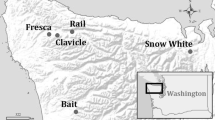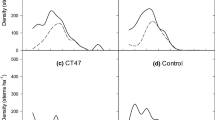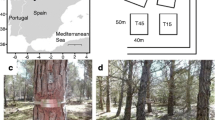Abstract
Pinus halepensis plantations are widespread throughout semiarid–subhumid landscapes of the Mediterranean. Recently, drought-induced decline has often been reported raising concerns with regard to the future of these man-made ecosystems. The study was set out to investigate thinning as a means to alleviate water stress and improve performance of mature P. halepensis plantations experiencing prolonged drought. The study was conducted in a 40-year-old P. halepensis forest in the Jerusalem Mountains of Israel (rainfall: 550 mm year−1). Declining stands (stand basal area increment, BAIstand ≈ −3 % year−1) were treated by thinning: (1) intense thinning—tree density, BAstand, and leaf area index (LAI) reduced by 81, 68, and 59 %, respectively; (2) moderate—56, 48, and 26 %, respectively; (3) control (~560 tree ha−1). Plots of 70 × 70 m were used in four replicates. Individual tree- to stand-level variables were monitored during 4 years through stem and leaf area metrics alongside with predawn shoot water potential (ψ PD) and tree mortality. Thinning ameliorated drought stress, reduced mortality, and improved individual tree growth (ψ PD = −1.7, −1.8, and −2.0 MPa; mortality = 0.2, 2, and 5 % year−1; BAItree = 3.4, 2.0, and 1.4 % year−1 in intense, moderate, and control treatments, respectively). Thinning effects became more pronounced with time. LAI and individual tree leaf area (LAtree) fluctuated with association to annual rainfall. Higher LAtree caused by thinning reflected a “selection effect” while increased leaf area efficiency (BAI per unit LAtree) was attributed to a “release effect” of thinning.




Similar content being viewed by others
References
Ákos Bede-Fazekas, Levente Horváth MK (2014) Impact of climate change on the potential distribution of Mediterranean pines. Quarterl J Hungarian Meteorol Serv 118:41–52
Aussenac G, Granier A (1988) Effects of thinning on water stress and growth in Douglas-fir. Can J For Res 18:100–105. doi:10.1139/x88-015
Bolotin M (1963) Growth of Pinus halepensis on the high mountain and low mountain in the south and in the north. La-Yaaran 13:94–99
Bonneh O (2000) Management of planted pine forests in Israel: past, present and future. In: Neemam G, Trabaud L (eds) Ecology, biogeography and management of Pinus halepensis and P. brutia forest ecosystems in the Mediterranean basin. Backnuys, Leiden, pp 377–390
Bréda N, Granier A, Barataud F et al (1995) Soil-water dynamics in an oak stand. I. Soil moisture, water potentials and water uptake by roots. Plant Soil 172:17–27. doi:10.1007/BF00020856
Chen JM, Rich PM, Gower ST et al (1997) leaf area index of boreal forests: theory, techniques, and measurements. J Geophys Res 102:29429–29443
De Luis M, Čufar K, Di Filippo A et al (2013) Plasticity in dendroclimatic response across the distribution range of Aleppo pine (Pinus halepensis). PLoS ONE. doi:10.1371/journal.pone.0083550
DeBell DS, Harrington C a, Shumway J (2002) Thinning shock and response to fertilizer less than expected in young Douglas-fir stand at wind river experimental forest. Res Pap PNW-RP-547 20
del Campo AD, Fernandes TJG, Molina AJ (2014) Hydrology-oriented (adaptive) silviculture in a semiarid pine plantation: how much can be modified the water cycle through forest management? Eur J For Res 133:879–894. doi:10.1007/s10342-014-0805-7
Derak M, Cortina J (2014) Multi-criteria participative evaluation of Pinus halepensis plantations in a semiarid area of southeast Spain. Ecol Indic 43:56–68. doi:10.1016/j.ecolind.2014.02.017
Dorman M, Svoray T, Perevolotsky A, Sarris D (2013) Forest performance during two consecutive drought periods: diverging long-term trends and short-term responses along a climatic gradient. For Ecol Manage 310:1–9. doi:10.1016/j.foreco.2013.08.009
Dorman M, Perevolotsky A, Sarris D, Svoray T (2015a) The effect of rainfall and competition intensity on forest response to drought: lessons learned from a dry extreme. Oecologia. doi:10.1007/s00442-015-3229-2
Dorman M, Svoray T, Perevolotsky A et al (2015b) What determines tree mortality in dry environments? A multi-perspective approach. Ecol Appl 25:1054–1071
Edward D, Reid B, Silins U, et al (2006) Sapwood hydraulic recovery following thinning in lodgepole pine. To cite this version: Original article Sapwood hydraulic recovery following thinning in lodgepole pine
Egan JM, Jacobi WR, Negron JF et al (2010) Forest thinning and subsequent bark beetle-caused mortality in Northeastern California. For Ecol Manage 260:1832–1842. doi:10.1016/j.foreco.2010.08.030
Fecko RM, Walker RF, Frederick WB et al (2008) Stem dimensional fluctuation in Jeffrey pine from variation in water storage as influenced by thinning and prescribed fire. Ann For Sci. doi:10.1051/forest:2007084
Gebhardt T, Haberle KH, Matyssek R et al (2014) The more, the better? Water relations of Norway spruce stands after progressive thinning. Agric For Meteorol 197:235–243. doi:10.1016/j.agrformet.2014.05.013
Girard F, Vennetier M, Guibal F et al (2012) Pinus halepensis Mill. crown development and fruiting declined with repeated drought in Mediterranean France. Eur J For Res 131:919–931. doi:10.1007/s10342-011-0565-6
Giuggiola A, Bugmann H, Zingg A et al (2013) Reduction of stand density increases drought resistance in xeric Scots pine forests. For Ecol Manage 310:827–835. doi:10.1016/j.foreco.2013.09.030
Gondard H, Romane F, Aronson J, Shater Z (2003) Impact of soil surface disturbances on functional group diversity after clear-cutting in Aleppo pine (Pinus halepensis) forests in southern France. For Ecol Manage 180:165–174. doi:10.1016/S0378-1127(02)00597-2
González-Ochoa AI, López-Serrano FR, De Las Heras J (2004) Does post-fire forest management increase tree growth and cone production in Pinus halepensis? For Ecol Manage 188:235–247. doi:10.1016/j.foreco.2003.07.015
Guillemot J, Delpierre N, Vallet P et al (2014) Assessing the effects of management on forest growth across France: insights from a new functional-structural model. Ann Bot. doi:10.1093/aob/mcu059
Gyenge J, Fernández ME, Sarasola M, Schlichter T (2011) Stand density and drought interaction on water relations of Nothofagus antarctica: contribution of forest management to climate change adaptability. Trees Struct Funct 25:1111–1120. doi:10.1007/s00468-011-0586-2
Harrington CA, Reukema DL (1983) Initial shock and long-term stand development following thinning in a Douglas-fir plantation. For Sci 29:33–46
Hernandez-Tecles E, Osem Y, Alfaro-Sanchez R, de las Heras J (2015) Vegetation structure of planted versus natural Aleppo pine stands along a climatic gradient in Spain. Ann For Sci. doi:10.1007/s13595-015-0490-9
Heth D, Speter A (1983) Development of Pinus halepensis and Pinus brutia as affected by thinning intensity levels. La-Yaaran 33:13–18
Kariuki M (2008) Modelling the impacts of various thinning intensities on tree growth and survival in a mixed species eucalypt forest in central Gippsland, Victoria, Australia. For Ecol Manage 256:2007–2017. doi:10.1016/j.foreco.2008.07.035
Klein T, Cohen S, Yakir D (2011) Hydraulic adjustments underlying drought resistance of Pinus halepensis. Tree Physiol 31:637–648. doi:10.1093/tpr047
Klein T, Shpringer I, Fikler B et al (2013) Relationships between stomatal regulation, water-use, and water-use efficiency of two coexisting key Mediterranean tree species. For Ecol Manage 302:34–42. doi:10.1016/j.foreco.2013.03.044
Kolb TE, Agee JK, Fulé PZ et al (2007) Perpetuating old ponderosa pine. For Ecol Manage 249:141–157. doi:10.1016/j.foreco.2007.06.002
Lagergren F, Lankreijer H, Kucera J et al (2008) Thinning effects on pine forest transpiration in central Sweden. For Ecol Manage 7:2312–2323. doi:10.1016/foreco.2007.12.047
Martín-Benito D, Del Río M, Heinrich I et al (2010) Response of climate-growth relationships and water use efficiency to thinning in a Pinus nigra afforestation. For Ecol Manage 259:967–975. doi:10.1016/j.foreco.2009.12.001
McJannet D, Vertessy R (2001) Effects of thinning on wood production, leaf area index, transpiration and canopy interception of a plantation subject to drought. Tree Physiol 21:1001–1008. doi:10.1093/treephys/21.12-13.1001
Mendel Z, Boneh O, Riov J (1992) Some foundations for the application of aggregation pheromone to control pine bark beetles in Israel. J Appl Entomol 114:217–227. doi:10.1111/j.1439-0418.1992.tb01119.x
Moreno-Gutiérrez C, Barberá GG, Nicolás E et al (2011) Leaf δ 18O of remaining trees is affected by thinning intensity in a semiarid pine forest. Plant Cell Environ 34:1009–1019. doi:10.1111/j.1365-3040.2011.02300.x
Ne’eman G, Goubitz S, Nathan R (2004) Reproductive traits of Pinus halepensis in the light of fire—a critical review. Plant Ecol 171:69–79. doi:10.1023/B:VEGE.0000029380.04821.99
O’Hara KL (1996) Dynamics and stocking-level relationships of multi aged ponderosa pine stands. For Sci 42:1–34
O’Hara KL, York RA (2014) Leaf area development and crown architecture in a Giant Sequoia spacing study. For Sci 60:776–783
Olivar J, Bogino S, Rathgeber C et al (2013) Thinning has a positive effect on growth dynamics and growth–climate relationships in Aleppo pine (Pinus halepensis) trees of different crown classes. Ann For Sci 71:395–404. doi:10.1007/s13595-013-0348-y
Osem Y, Ginsberg P, Tauber I et al (2008) Sustainable management of Mediterranean planted coniferous forests: an Israeli definition. Int For 106:38–46
Osem Y, Zangy E, Bney-Moshe E et al (2009) The potential of transforming simple structured pine plantations into mixed Mediterranean forests through natural regeneration along a rainfall gradient. For Ecol Manage. doi:10.1016/j.foreco.2009.09.034
Osem Y, Lavi A, Rosenfeld A (2011) Colonization of Pinus halepensis in Mediterranean habitats: consequences of afforestation, grazing and fire. Biol Invasions. doi:10.1007/s10530-010-9843-3
Osem Y, Yavlovich H, Zecharia N et al (2013) Fire-free natural regeneration in water limited Pinus halepensis forests: a silvicultural approach. Eur J For Res 132:679–690
Osem Y, Fogel T, Moshe Y, Brant S (2015) Managing cattle grazing and overstorey cover for the conversion of pine monocultures into mixed Mediterranean woodlands. Appl Veg Sci 18:261–271. doi:10.1111/avsc.12152
Quezel P (2000) Taxonomy and biogeography of Mediterranean pines (Pinus halepensis and P. brutia. In: Ne’eman G, Trabaud L (eds) Ecology, biogeography and managememnt of Pinus halepensis and P. brutia forest ecosysytems in the Mediterranean basin. Backnuys, Leiden, pp 1–12
Rais A, van de Kuilen JW, Pretzsch H (2014) Growth reaction patterns of tree height, diameter, and volume of Douglas-fir (Pseudotsuga menziesii [Mirb.] Franco) under acute drought stress in Southern Germany. Eur J For Res. doi:10.1007/s10342-014-0821-7
Raz-Yaseef N, Rotenberg E, Yakir D (2010) Effects of spatial variations in soil evaporation caused by tree shading on water flux partitioning in a semi-arid pine forest. Agric For Meteorol 150:454–462. doi:10.1016/j.agrformet.2010.01.010
Reich PB, Hinckley TM (1989) Influence of pre-dawn water potential and soil-to-leaf hydraulic conductance on maximum daily leaf diffusive conductance in two oak species. Funct Ecol 3:719–726. doi:10.2307/2389504
Ruano I, Rodríguez-García E, Bravo F (2013) Effects of pre-commercial thinning on growth and reproduction in post-fire regeneration of Pinus halepensis Mill. Ann For Sci 70:357–366. doi:10.1007/s13595-013-0271-2
Saha S, Strazisar TM, Menges ES et al (2008) Linking the patterns in soil moisture to leaf water potential, stomatal conductance, growth, and mortality of dominant shrubs in the Florida scrub ecosystem. Plant Soil 313:113–127. doi:10.1007/s11104-008-9684-3
Sánchez-Salguero R, Navarro-Cerrillo RM, Camarero JJ, Fernández-Cancio Á (2012a) Selective drought-induced decline of pine species in southeastern Spain. Clim Change 113:767–785. doi:10.1007/s10584-011-0372-6
Sánchez-Salguero R, Navarro-Cerrillo RM, Swetnam TW, Zavala MA (2012b) Is drought the main decline factor at the rear edge of Europe? The case of southern Iberian pine plantations. For Ecol Manage 271:158–169. doi:10.1016/j.foreco.2012.01.040
Sánchez-Salguero R, Camarero JJ, Dobbertin M et al (2013) Contrasting vulnerability and resilience to drought-induced decline of densely planted vs. natural rear-edge Pinus nigra forests. For Ecol Manage 310:956–967. doi:10.1016/j.foreco.2013.09.050
Sarris D, Christodoulakis D, Körner C (2011) Impact of recent climatic change on growth of low elevation eastern Mediterranean forest trees. Clim Change 106:203–223. doi:10.1007/s10584-010-9901-y
Sarris D, Siegwolf R, Körner C (2013) Inter- and intra-annual stable carbon and oxygen isotope signals in response to drought in Mediterranean pines. Agric For Meteorol 168:59–68. doi:10.1016/j.agrformet.2012.08.007
Schiller G (1976) The effect of thinning on the development of a Pinus halepensis forest. LaYaaran 26:5–9
Schiller G (2000) Ecophysiology of Pinus halepensis Mill and P. brutia Ten. In: Ne’eman G, Trabaud L (eds) Ecology, biogeography and management of Pinus halepensis and P. brutia forest ecosystems in the Mediterranean basin. Backnuys, Leiden, pp 51–66
Sheffer E, Canham CD, Kigel J, Perevolotsky A (2014) An integrative analysis of the dynamics of landscape- and local-scale colonization of Mediterranean Woodlands by Pinus halepensis. PLoS ONE 9:e90178. doi:10.1371/journal.pone.0090178
Simonin K, Kolb TE, Montes-Helu M, Koch GW (2006a) Restoration thinning and influence of tree size and leaf area to sapwood area ratio on water relations of Pinus ponderosa. Tree Physiol 26:493–503. doi:10.1093/treephys/26.4.493
Simonin K, Kolb TE, Montes-Helu M, Koch GW (2006b) Restoration thinning and influence of tree size and leaf area to sapwood area ratio on water relations of Pinus ponderosa. Tree Physiol 26:493–503. doi:10.1093/treephys/26.4.493
Simonin K, Kolb TE, Montes-Helu M, Koch GW (2007) The influence of thinning on components of stand water balance in a ponderosa pine forest stand during and after extreme drought. Agric For Meteorol 143:266–276. doi:10.1016/j.agrformet.2007.01.003
Skov KR, Kolb TE, Wallin KF (2004) Tree size and drought affect Ponderosa pine physiological response to thinning and burning treatments. For Sci 50:1–11
Sohn JA, Gebhardt T, Ammer C et al (2013) Forest ecology and management mitigation of drought by thinning: short-term and long-term effects on growth and physiological performance of Norway spruce (Picea abies). For Ecol Manage 308:188–197. doi:10.1016/j.foreco.2013.07.048
Sprintsin M, Cohen S, Maseyk K et al (2011) Long term and seasonal courses of leaf area index in a semi-arid forest plantation. Agric For Meteorol 151:565–574. doi:10.1016/j.agrformet.2011.01.001
Stone JE, Kolb TE, Covington WJ (1999) Effects of restoration thinning on presettlement Pinus ponderosa in northern Arizona. Restor Ecol 7:172–182. doi:10.1046/j.1526-100X.1999.72009.x
Stoneman GL, Crombie DS, Whitford K et al (1997) Growth and water relations of Eucalyptus marginata (jarrah) stands in response to thinning and fertilization. Tree Physiol 17:267–274. doi:10.1093/treephys/17.4.267
Tarpey RA, Jurgensen MF, Palik BJ, Kolka RK (2008) The long-term effects of silvicultural thinning and partial cutting on soil compaction in red pine (Pinus resinosa Ait.) and northern hardwood stands in the northern Great Lakes Region of the United States. Can J Soil Sci 88:849–857
Tesemma ZK, Wei Y, Western AW, Peel MC (2014) Leaf area index variation for cropland, pasture and tree in response to climatic variation in the Goulburn–Broken catchment, Australia. J Hydrometeorol. doi:10.1175/JHM-D-13-0108.1
Ungar ED, Rotenberg E, Raz-Yaseef N et al (2013) Transpiration and annual water balance of Aleppo pine in a semiarid region: implications for forest management. For Ecol Manage 298:39–51. doi:10.1016/j.foreco.2013.03.003
van der Maaten E (2013) Thinning prolongs growth duration of European beech (Fagus sylvatica L.) across a valley in southwestern Germany. For Ecol Manage 306:135–141. doi:10.1016/j.foreco.2013.06.030
Waring RH (1983) Estimating forest growth and efficiency in relation to canopy leaf area. Adv Ecol Res 13:327–354
Weitz Y (1969) Pruning and thinning pine trees. La-Yaaran 19:78–86
Whicker JJ, Pinder JE, Breshears DD (2008) Thinning semiarid forests amplifies wind erosion comparably to wildfire: implications for restoration and soil stability. J Arid Environ 72:494–508. doi:10.1016/j.jaridenv.2007.08.006
Zausen GL, Kolb TE, Bailey JD, Wagner MR (2005) Long-term impacts of stand management on ponderosa pine physiology and bark beetle abundance in northern Arizona: a replicated landscape study. For Ecol Manage 218:291–305. doi:10.1016/j.foreco.2005.08.023
Acknowledgments
This work was funded by the Israeli Forest Service (KKL). We thank Päivi Yuval, Elad Spiegel, and Yaara Harel for field work assistance.
Author information
Authors and Affiliations
Corresponding author
Rights and permissions
About this article
Cite this article
Calev, A., Zoref, C., Tzukerman, M. et al. High-intensity thinning treatments in mature Pinus halepensis plantations experiencing prolonged drought. Eur J Forest Res 135, 551–563 (2016). https://doi.org/10.1007/s10342-016-0954-y
Received:
Revised:
Accepted:
Published:
Issue Date:
DOI: https://doi.org/10.1007/s10342-016-0954-y




